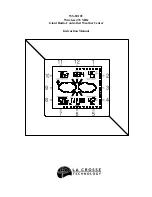
Installation/Configuration ER600
29
29) Press
. Press
to play the vocal name of the input
30) Press
. To record, press
.
31) Press
. Press
to cancel the vocal message of the input.
32) Press
to program another input of the device repeating the procedure from step 6. Press
again to program the other wireless devices of the same radio expansion module and repeat the
procedure from step 5. Press
again to program the devices of another radio expansion
module and repeat the procedure from step 3.
33) Press
repeatedly to exit from the menu.
IMPORTANT!
Program all inputs used in the system.
9.2
WIRELESS OUTPUT PROGRAMMING
The wireless outputs are available only if the radio expansion module is installed.
Each ER600 radio expansion module can manage up to two wireless sirens. There are no other wireless output types.
9.2.1
Wireless output encoding
Each output has two addresses: a physical address and a logical address. The two addresses are displayed as follows:
physical address
→
logical address
and in detail
ddXX
U
Y:
→
U
ZZ
where:
dd
is the type of wireless device assigned to an ER600 module
XX
is the sequential number of the wireless devices acquired as outputs,
Y
is the number of the XX wireless device output (physical address).
ZZ
is the two-digit logical address of the output that the control panel assigns sequentially as the wireless devices are assigned.
The physical address is useful for installers during system installation and maintenance. It may appear on the display in other form
(ER= radio expansion, HP = siren).
The logical address can be changed at any time by the installer.
MP500/xx systems identify the outputs on the display by showing physical address, logical address and name. Vocal and number
alarms, on the other hand, are identified by means of the logical address and the customised message (if any) only.
During wireless device acquisition, the control panel automatically assigns a sequential logical address in sequence to the outputs of
the control panel itself and to any other outputs of the EP508 expansions and of the AS500 auxiliary power unit.
9.2.2
Wireless output customisation
The output customisation defines which events caused activation of the siren.
Possible wireless output customisations are: Burglar, Pre-alarm, Tamper, Panic, Fire, Burglar/Tamper.
9.2.3
Status report
The wireless sirens may optionally display the system status as an optical-auditory indication or an optical indication only. The status
report indication must be enabled during programming.
VOCAL NAME
PLAY
VOCAL NAME
RECORD
VOCAL NAME
DELETE
Siren audio
Light alarm indication
Armed/Partially armed
1 beep*
3 LED groups blink once
Disarmed
2 beeps*
Blinking in sequence for 1 cycle
Armed with battery low
3 beeps
3 LED groups blink 3 times
Disarmed with battery low
3 beeps
Blinking in sequence for 3 cycles
Armed with Tamper open
5 beeps
3 LED groups blink 5 times
Disarmed with Tamper open
5 beeps
Blinking in sequence for 5 cycles
Entrance/exit sounds
Countdown beeps
















































